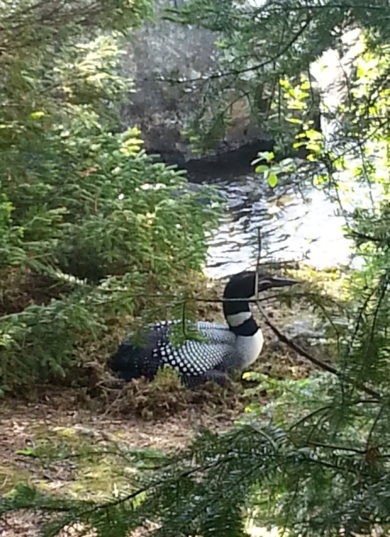Six New Loon Pairs
SIX NEW LOON PAIRS AND THE FIRST NESTING LOON FOUND IN CHITTENDEN COUNTY THIS YEAR
A Common Loon nesting on a raft at Goshen Dam. / © Sue Wetmore
 Just when we anticipate that Vermont’s breeding Common Loon population will stabilize, after years of steady growth, loons inevitably find new places to nest. Six new nesting pairs have been documented so far this year, and surprisingly only two are situated in the lake district of northern Vermont (Caspian Lake and Curtis Pond). Two new pairs have formed in west-central Vermont on Goshen Dam and Chittenden Reservoir, while one has nested on Lake Raponda in southern Vermont. The biggest news, geographically speaking, is that a pair has nested for the first time in recent history on Lake Iroquois in Chittenden County.
Just when we anticipate that Vermont’s breeding Common Loon population will stabilize, after years of steady growth, loons inevitably find new places to nest. Six new nesting pairs have been documented so far this year, and surprisingly only two are situated in the lake district of northern Vermont (Caspian Lake and Curtis Pond). Two new pairs have formed in west-central Vermont on Goshen Dam and Chittenden Reservoir, while one has nested on Lake Raponda in southern Vermont. The biggest news, geographically speaking, is that a pair has nested for the first time in recent history on Lake Iroquois in Chittenden County.
Like many first time pairs, some nested in difficult locations and did not succeed this year, but the birds will likely be back next year to try again. On Lake Iroquois, the nest was located on an island with an active cottage on it. It is likely the birds just spent too much time off the nest when wary about human and dog activity. The owners are excited to have the loons there, so we will be working on some management strategies for next year with them.
Common Loon nest found in a difficult place on Caspian Lake. / © Will Lyman
 On Caspian Lake, the pair nested on a point of land about six feet from the water up a very steep bank. They quickly gave up after laying an egg due to the difficulty of reaching the nest and/or predators taking the egg. Before they actually laid the egg, the landowners had contacted us and realizing the chances of success for this nest were not high, we placed a raft around the corner in hopes of luring them to a slightly better spot. Within two weeks, the pair renested on the raft. It’s still not ideal as waves hit it at times and it is still relatively close to human activity. Caspian Lake has no islands or marshes and the longest section of undeveloped shore on the entire lake is less than 200 feet long. In addition, a large number of cottages are rented, which adds to the difficulty of creating a “quiet” area for nesting. As of July 5th, a loon was still sitting on the Caspian Lake raft.
On Caspian Lake, the pair nested on a point of land about six feet from the water up a very steep bank. They quickly gave up after laying an egg due to the difficulty of reaching the nest and/or predators taking the egg. Before they actually laid the egg, the landowners had contacted us and realizing the chances of success for this nest were not high, we placed a raft around the corner in hopes of luring them to a slightly better spot. Within two weeks, the pair renested on the raft. It’s still not ideal as waves hit it at times and it is still relatively close to human activity. Caspian Lake has no islands or marshes and the longest section of undeveloped shore on the entire lake is less than 200 feet long. In addition, a large number of cottages are rented, which adds to the difficulty of creating a “quiet” area for nesting. As of July 5th, a loon was still sitting on the Caspian Lake raft.
The new loon pairs on Lake Raponda and Chittenden Reservoir have produced chicks, but the Curtis Pond pair has likely failed. Incubation has continued too long, which usually indicates eggs that are not viable. The Goshen Dam pair is still incubating. It’s too early to tell how chick numbers will compare to previous years, but we are receiving many reports of intruder loons and stashed and potentially lost chicks.
Curtis Pond nest. / © Colleen Bloom
Even with the increased number of nesting pairs in Vermont, the actual number of chicks that survive might remain stable each year due to competition. It’s all part of loon life.


